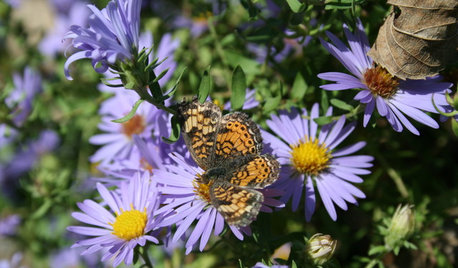Morality of collecting native plants threatened by garlic mustard
birdgardner
19 years ago
Related Stories

GARDENING GUIDESGarden-Friendly Native Alternatives to Overplanted Exotics
There are lots of gorgeous, wildlife-friendly native plants ready to make an appearance in your garden
Full Story
GARDENING GUIDESHow to Find the Right Native Plants for Your Yard
Find plant maps, sale sites and guides that make going native in the garden easier than ever
Full Story

GARDENING GUIDESGreat Design Plant: Silphium Perfoliatum Pleases Wildlife
Cup plant provides structure, cover, food and water to help attract and sustain wildlife in the eastern North American garden
Full Story
EARTH DAYHow to Design a Garden for Native Bees
Create a garden that not only looks beautiful but also nurtures native bees — and helps other wildlife in the process
Full Story
GARDENING GUIDES6 Plants That Beat Butterfly Bush for the Wildlife Draw
It's invasive, a nonnative and a poor insect magnet. Check out these better alternatives to butterfly bush in the garden
Full Story
GARDENING GUIDESAttract Hummingbirds and Bees With These Beautiful Summer Flowers
Roll out a welcome mat for pollinators to keep your landscape in balance and thriving
Full Story
GARDENING GUIDESTop 12 Summer-Blooming Perennials for Deer-Resistant Drama
Can you have garden color, fragrance and exciting foliage with hungry deer afoot? These beauties say yes
Full Story
EDIBLE GARDENSWhy Grow Quince? For Beauty, Fragrance and Old-Time Flavor
Delightfully perfumed fruit and lovely spring blossoms make this apple and pear cousin worth a spot in the garden
Full Story
HOLIDAYSThese Homes Say Happy Mardi Gras!
Let the good times roll around the house with Mardi Gras beads, glittery high heels, Fat Tuesday colors and more
Full Story


fredsbog
jillmcm
Related Discussions
Interest in Native Plants?
Q
Garlic mustard seed
Q
garlic mustard and ? knotweed ? good/bad idea to...
Q
New natives growing and planting.
Q
stephenNJ
fredsbog
RUDE_RUDY
geoforce
birdgardnerOriginal Author
Fledgeling_
jillmcm
Fledgeling_
birdgardnerOriginal Author
oakleif
nacnud
birdgardnerOriginal Author
shapiro
Gentian_NY
Hooti
RUDE_RUDY
mikeLHS68
Elena_Madrid
chuckr30
taylmat_OK
knottyceltic
vagarden
joepyeweed
jillhudock
ahughes798
oldroser
jancarkner
grumpygardenguy
Fledgeling_
RUDE_RUDY
mytime
Fledgeling_
nrynes
davidl_ny5
flowersandthings